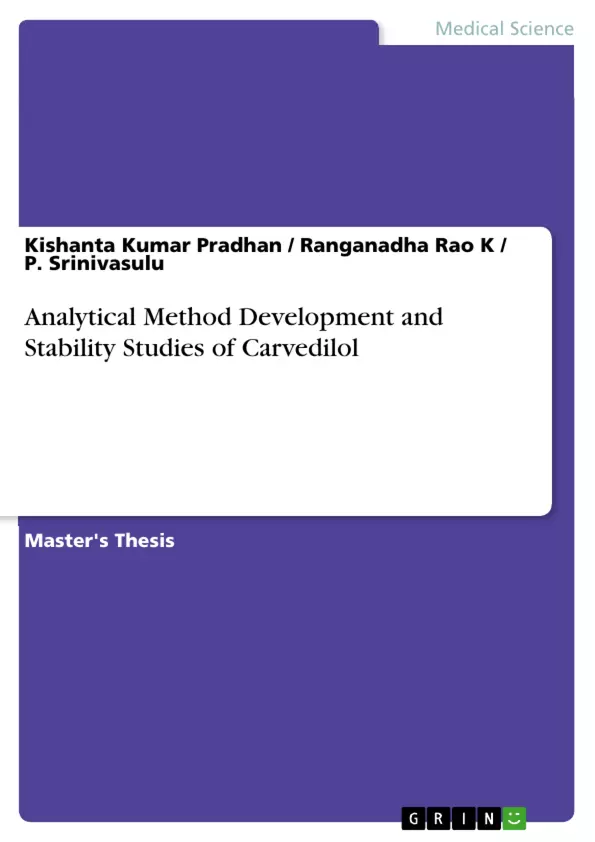A reverse phase high performance liquid chromatographic method (HPLC) has been developed for the method development validation of Carvedilol in bulk and pharmaceutical formulation by using YMC PACK PRO 4.6 X 150 mm (5µm Particle size). The mobile phase was Buffer: Acetonitrile: (70:30) and pH was adjusted to 2 pumped at a flow rate of 1 ml/min and the eluents were monitored at 320nm. Linearity was obtained in the concentration range of 10-90 μg/ml. The retention time of Carvedilol was found to be 3.2 minute. The method was validated for specificity, accuracy, precision, linearity, and limit of detection, limit of quantification, robustness and solubility stability. LOD and LOQ were found to be 0.001 μg/ml and 0.011μg/ml respectively. The method was statistically validated and RSD was found to be less than 2% indicating high degree of accuracy and precision of the proposed HPLC method. Stability study report revealed that the drug is susceptible for acidic, alkaline, oxidative, photolytic and UV degradation. The drug is stable to thermal degradation. More over the degradants were well separated from its API. Due to its simplicity, rapidness, high precision and accuracy, the proposed HPLC method may be used for determining Carvedilol in bulk drug samples or in pharmaceutical dosage forms.
Inhaltsverzeichnis (Table of Contents)
- CHAPTER: 1 INTRODUCTION
- 1. Introduction
- CHAPTER: 2 LITERATURE REVIEW
- 2.1 Literature review
- CHAPTER: 3 PROLOGUES TO THE EXPERIMENTAL WORK
- 3.1 Scope and objectives
- 3.2 Plan of work
- 3.3 Requirements
- CHAPTER: 4 EXPERIMENTAL
- 4.1 UV-VIS method development
- 4.2 RP-HPLC method development
- 4.3 Forced degradation Studies
- CHAPTER: 5 RESULTS AND DISCUSSION
- 5.1 UV-VIS Analysis
- 5.2 RP-HPLC Analysis
- 5.3 Forced degradation studies
- CHAPTER: 6 CONCLUSIONS
- 6.1 Conclusion
- CHAPTER: 7 REFERENCES
- 7.1 References
Zielsetzung und Themenschwerpunkte (Objectives and Key Themes)
This thesis focuses on the development and validation of analytical methods for the drug carvedilol, followed by a comprehensive stability study using forced degradation techniques. The primary objective is to establish reliable and accurate analytical methods for the quantification of carvedilol in various pharmaceutical formulations.
- Analytical Method Development and Validation
- Stability Studies of Carvedilol
- Forced Degradation Techniques
- UV-Vis Spectrophotometry
- RP-HPLC Analysis
Zusammenfassung der Kapitel (Chapter Summaries)
Chapter 1 provides an introduction to spectrophotometric methods, highlighting their importance in pharmaceutical analysis. The chapter delves into the principles of UV-Vis spectroscopy and its applications in drug analysis. Chapter 2 presents a comprehensive literature review on the analytical methodologies and stability studies of carvedilol, summarizing existing research and providing context for the current work. Chapter 3 outlines the scope, objectives, plan, and requirements of the experimental work. Chapter 4 details the experimental methodologies employed for developing and validating UV-Vis and RP-HPLC methods for carvedilol analysis, along with the forced degradation studies performed to assess the drug's stability. Chapter 5 presents and discusses the results obtained from the experimental work, analyzing the performance of the developed methods and the stability of carvedilol under various conditions. Chapter 6 concludes the thesis by summarizing the key findings and highlighting the significance of the research.
Schlüsselwörter (Keywords)
Carvedilol, analytical method development, UV-Vis spectrophotometry, RP-HPLC, stability studies, forced degradation, pharmaceutical analysis, drug quantification, analytical validation.
- Quote paper
- M. Pharm., Ph. D. Kishanta Kumar Pradhan (Author), M. Pharm. Ranganadha Rao K (Author), M. SC., PhD P. Srinivasulu (Author), 2011, Analytical Method Development and Stability Studies of Carvedilol, Munich, GRIN Verlag, https://www.grin.com/document/295262



